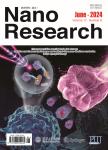Impact of insulator layer thickness on the performance of metal-MgO-ZnO tunneling diodes
Impact of insulator layer thickness on the performance of metal-MgO-ZnO tunneling diodes作者机构:State Key Laboratory for Advanced Metals and Materials School of Materials Science and Engineering University of Science and Technology Beijing Beijing 100083 China Beijing Municipal Key Laboratory of New Energy Materials and Technologies Beijing 100083 China School of Electrical and Electronic Engineering University of Manchester Manchester M13 9PL UK
出 版 物:《Nano Research》 (纳米研究(英文版))
年 卷 期:2016年第9卷第5期
页 面:1290-1299页
核心收录:
学科分类:080903[工学-微电子学与固体电子学] 0808[工学-电气工程] 080803[工学-高电压与绝缘技术] 0809[工学-电子科学与技术(可授工学、理学学位)] 08[工学] 080501[工学-材料物理与化学] 0805[工学-材料科学与工程(可授工学、理学学位)] 080502[工学-材料学]
基 金:Acknowledgements This work was supported by the National Basic Research Program of China (No. 2013CB932602) the Program of Introducing Talents of Discipline to Universities (No. B14003) National Natural Science Foundation of China (Nos. 51572021 51527802 and 51232001) Beijing Municipal Science & Technology Commission and the Fundamental Research Funds for Central Universities. M. A. M. and Y. Z. would also like to acknowledge the support of the Newton International Research Collaboration Programme (No. NRCP/1415/129)
主 题:metal-insulator-semicon ductor (MIS) diode ZnO nanodevices MgO layer tunneling mechanism
摘 要:The performance of metal-insulator-semiconductor (MIS) type tunneling diodes based on ZnO nanostructures is investigated through modeling. The framework used in this work is the Schr6dinger equation with an effective-mass approximation. The working mechanism of the MIS type tunneling diode is investigated by examining the electron density, electric field, electrostatic potential, and conduction band edge of the device. We show that a valley in the electrostatic potential is formed at the ZnO/MgO interface, which induces an energy barrier at the ZnO side of this interface. Therefore, electrons need to overcome two barriers: the high and narrow MgO barrier, and the barrier from the depletion region induced at the ZnO side of the ZnO/MgO interface. As the MgO layer becomes thicker, the valley in electrostatic potential becomes deeper. At the same time, the barrier induced at the ZnO/MgO interface becomes higher and wider. This leads to a fast decrease in the current passing through the MIS diode. We optimize the thickness of the MgO insulating layer, sandwiched between a ZnO film (in this work we use a single ZnO nanowire) and a metal contact, to achieve maximum performance of the diode, in terms of rectification ratio. An optimal MgO layer thickness of 1.5 nm is found to yield the highest rectification ratio, of approximately 169 times that of a conventional metal-semiconductor-metal Schottky diode. These simulated results can be useful in the design and optimization of ZnO nanodevices, such as light emitting diodes and UV photodetectors.



